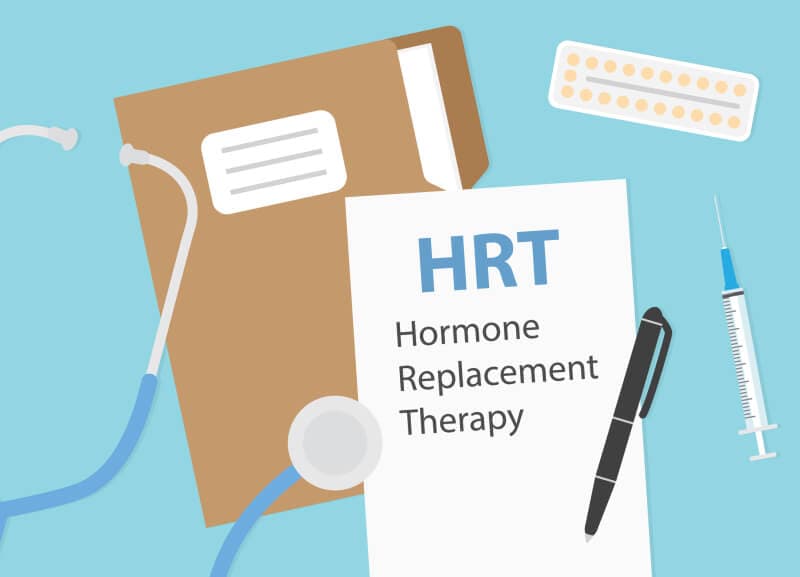
Menopause is a normal life event that happens for every woman. During this life-changing period, the hormone levels constantly fluctuate which can cause menopausal symptoms of varying degrees but more often than not, these symptoms can greatly affect the quality of life. One therapy option to get relief from the severe effects of menopause is hormone treatment.
So what are the effects of hormone replacement therapy on a female patient? Hormone therapy works by supplying the hormones that the body has stopped producing to ease the symptoms of hormonal imbalance. Each patient may respond differently to the hormones given and may experience side effects like breast tenderness, nausea, weight gain, bloating, irregular bleeding, and mood swings. You may need to wait at least three months to feel the full effects of the HRT.
Hormone replacement therapy is a treatment recommended for women who are suffering from the debilitating symptoms of menopause. This is sometimes called menopausal hormone replacement therapy or postmenopausal hormone therapy. Generally, it involves prescriptions of various hormone medications to save the declining hormone levels and bring them back to healthy amounts.
The two main types of hormones used for hormone therapy are estrogen and progesterone. Progestogen and progestin are the synthetic forms of the natural progesterone hormone which are also used for HRT drugs.
The kind of hormone therapy that you will receive will be based upon your current menopause conditions and will also take your medical history into consideration. To explain the effect of hormone replacement therapy HRT on the female patient, you first need to be familiar with the different categories of the treatment:
Estrogen therapy, or unopposed estrogen, is a hormone treatment that only administers pure estrogen. Taking estrogen alone is favorable for women who have had a hysterectomy to remove their uterus. In most cases, high levels of estrogen in women with a uterus may cause the cells in the endometrium lining to grow and result in endometrial hyperplasia.
Estrogen hormone therapy is one of the most effective prescriptions for treating vasomotor symptoms and vaginal dryness during menopause. The common preparations for estrogen medications are conjugated estrogen and estradiol.
Combination hormone replacement therapy uses both estrogen and progesterone. This type is commonly prescribed for women who still have their uterus intact. The addition of progesterone in the hormone formulation helps to balance the oestrogen levels in the body to lower the risk for womb cancer.
There are two approaches for taking combination HRT: continuous and sequential. Continuous combined HRT basically means that you will take both estrogen and progesterone together for a whole month without any break. Postmenopausal women are usually advised to take this approach.
On the other hand, sequential or cyclical HRT is a method where you will take estrogen for the first 14 days of the month and then both estrogen and progesterone for the remaining days. Combination HRT is usually given at the lowest doses to lessen the adverse effects of the hormones.
Lately, there’s been talk about the new bioidentical hormone replacement therapy which uses compounded hormones that are chemically identical to the ones that the body produces. Some of the bioidentical hormones include micronized progesterone, estradiol acetate, and estradiol hemihydrate. These are usually made from natural plant sources which are why many manufacturers claim that they are a safer alternative to traditional HRT.
However, there are not enough studies and evidence to support the claims. Rest assured that when administered properly, bioidentical hormone therapy can offer the same benefits to menopausal women. The risks and complications that it carries are similar to taking traditional hormones.
The results from hormone replacement therapy are not immediate. It will need some time for the hormones to settle in your system, while your body will undergo some adjustments to adapt to the changing hormone levels. It’s not uncommon to experience some side effects as a result of your body responding to the treatment. Some of the usual side effects from HRT are:
While HRT is generally a safe treatment, there are certain risks that are associated with its long-term use. Ideally, women who are using HRT for primary relief from menopause symptoms should only be on hormones for two to three years. They also need to be regularly monitored to check for any signs of increased health risks such as:
Combination hormone therapy is said to increase breast cancer risk, especially during the first three years that you are receiving the medication. Factors that can affect the possibilities for breast cancer are the length of time that you are the hormone medications and the dosage that you are receiving. Higher doses of combined HRT usually pose higher risks for breast cancer. Stopping HRT may bring down your risk for breast cancer to the average percent.
If you’re taking estrogen hormone therapy, the breast cancer risk is said to increase only when you take the medications for more than 10 years. In fact, women who have had a hysterectomy and are only taking oestrogen may have decreased breast cancer incidence.
Female patients who still have their uterus will have increased endometrial cancer risk if they are receiving unopposed estrogen. Meanwhile, there are relatively low chances for endometrial cancer for those who are taking estrogen and progesterone, as well as those who have had a prior hysterectomy.
Women over the age of 60 who are taking HRT may have increased risks for heart disease and stroke. The risk is associated with those who are receiving oral estrogen medications and combination hormones. To avoid this, you may be advised to switch to transdermal HRT or lower the number of doses.
There is also a small increased possibility for blood clots which can develop into deep vein thrombosis among patients taking HRT. The risk is potentially high for the first year of treatment, particularly for oral combined hormone therapy. This can also be influenced by other factors such as age, weight, and lifestyle factors (if you’re smoking or not).
Hormone therapy has also been linked to a small increased risk for ovarian cancer for female patients. It is believed that this possibility is especially high for women who are taking hormones after menopause. Those taking oestrogen-only for more than 10 years may also be more susceptible to this type of cancer.

Most of the studies done on hormone therapy show that serious complications are more prevalent in women older than 60 years. But for younger patients who start HRT because of early menopause or due to a hysterectomy, the benefits seem to outweigh the risks. Some of the advantages of hormone therapy are:
But before getting menopausal hormone therapy, your doctor will first need to determine if you are a good candidate for the treatment. The therapy is usually not allowed for patients with the following contraindications:
Hormone therapy is usually given systemically which means that the hormones enter and circulate throughout the body via the bloodstream. The most popular form of HRT is oral HRT which are the pills and tablets that are taken by mouth. Many oral hormone medications are taken once a day without food.
Topical applications of hormones are also available via creams, gels, and sprays. In this option, the hormones are absorbed through the skin and it is safer for menopausal women with liver and cholesterol diseases. There are also skin patches that can be placed on the skin on your lower stomach.
Local HRT or vaginal estrogen is also available by means of creams, vaginal rings, or tablets. They usually contain a low amount of estrogen and they work best for treating urogenital conditions such as vaginal dryness, vaginal atrophy, itching, and urinary problems.

Most of the female body’s reproductive functions and physical traits are influenced by the estrogen hormone. There are three estrogen types that you need to know: estradiol which is present in all women of reproductive age, estriol which is abundant during pregnancy, and estrone which is the only estrogen that is produced after menopause.
Estrogen is primarily responsible for controlling the start of menstrual cycles. When a woman nears menopause, estrogen levels drastically drop and it is often the leading cause of most menopausal symptoms like irregular periods, vaginal dryness, hot flushes, sleep problems, mood swings, low sexual desire, migraines, and dry and itchy skin problems.
Once you’re postmenopausal, your ovaries stop producing estrogen and you’ll only get your supply from the fat tissues. However, your hormone levels will still remain below normal baseline levels. Because of this, many women over the age of 60 are prone to health complications such as osteoporosis, cardiovascular disease, depression, and more.
Menopausal hormone therapy is one way to restore hormonal balance after menopause. It also helps to maintain your health so that your risks of experiencing postmenopausal health conditions are lowered in the long run.
There are numerous factors that are considered when you decide to get hormone treatment. Among these are your age, health, the extent of menopausal symptoms, and your desired treatment goals. These can help your provider to determine what type of HRT you will receive and once you start taking them, there are things that you can do to assure that you get the most of the treatments:
Hormone therapy lets menopausal and postmenopausal women live a comfortable life free from the effects of hormonal imbalance. Here at Revitalize You MD, we offer safe and quality hormone replacement therapy plans that are catered to your condition.
Our highly trained medical staff and doctors will assess your needs before prescribing the appropriate hormone treatment plan for you. At Revitalize You MD, we take steps to ensure that you will receive the best plan to achieve total wellness. Call us today and book your first appointment.
The staff is great, the products work!! I am very pleased with my results!